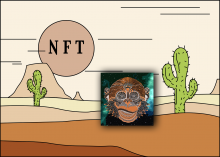
photo: Eugene Capon from Pexels
What is the metaverse? In the simplest of terms, it is a virtual space in which users are and will be able to interact and connect with each other in myriad ways – gaming, collaborating, shopping, and exploring – without leaving the comfort of their couch. Some of this functionality already exists in gaming platforms.
What is envisioned is nothing short of a sophisticated make-believe world in which consumers can experience life virtually. For example, shoppers can buy virtual products, online simulacrums of a real item with which to adorn their avatar or can attend concerts and sporting events as virtual VIPs, buy expensive and unique works of art, drive virtual autos or yachts, travel and dine in special and exotic locations and more. The metaverse is expanding day by day.
Many of these new virtual experiences or goods will have the added allure of being an NFT (read more about IP and NFTs), a unique digital creation. And lots of not so imaginary value will be created, as consumers of this new virtual and augmented reality spend real money, albeit in the form of digital currencies, to participate.
While the metaverse is still developing, it has gained a foothold in a number of sectors. The gaming universe, for example has been a leader in developing new space, with gamers able to make in-game purchases using the virtual in-game currency of digital objects, like “skins”.
Sports leagues are joining in, with opportunities for purchasing NFT trading cards, or attending the next generation of fantasy league events. Participants can attend a virtual musical event like a concert by American rapper Travis Scott. This is just the beginning. The metaverse is expected to expand, becoming a richer environment for the user community.
Meta, the Mark Zuckerberg-led company that owns Facebook, is deep in development as it attempts to capture the bounty of the Metaverse for itself. But other tech companies, from Microsoft to gaming companies like Nvidia and Roblox, are equally eager to capture as much real estate in the metaverse as they can.
As is the case in the physical world, there are a host of legal issues that will arise in the metaverse. Privacy and data collection, antitrust or anti-competition, free speech and defamation, as well as intellectual property issues, from copyright to patents to trademarks. For brand owners, protecting their brands in the metaverse will be critical, and getting ready to play in the new meta sandbox will require a legal strategy.
Brand owners should be considering how to construct their virtual marketplace with appropriate trademark registrations, a robust policing strategy and appropriate licenses and terms of use as they look to grow in the metaverse.
Protecting your brand for the metaverse ─ registration and beyond
If your company is contemplating selling branded virtual goods and services in the metaverse, trademark applications should be filed as soon as possible. But how do you apply to protect your brand for a digital sneaker? A virtual tote? What description of goods and services is appropriate, and what classifications are apt?
Some companies have already implemented broad filing programs. Several are footwear giants such as Nike and Converse, both of which recently filed a number of applications in the United States Patent and Trademark Office. And, not surprisingly, companies in the fashion, cosmetics, sports and entertainment industries are also filing applications for their marks for use in connection with virtual offerings. While these applications have yet to undergo scrutiny, they offer a road map of potential ways to achieve trademark registrations for virtual goods.
It appears that companies are filing for protection in relation to the following classes of goods (read more about international classification of goods and services) – downloadable virtual goods, namely computer programs (class 9), retail store services featuring virtual goods (class 35), entertainment services (class 35), on-line non downloadable virtual goods and NFTs (class 42), and financial services, including digital tokens (class 36). As these applications are examined by various trademark offices, the descriptions of goods and services, as well as classification issues, will likely become more standardized, and those guidelines will serve later applicants.
In most jurisdictions, the first to file owns the rights in the trademark. And even in the United States, where actual use in commerce will trump a prior filing date, early filing on an intent to use basis is critical, as the date of filing will establish the first use date, even if actual use occurs later.
Not surprisingly, bad actors are trying to usurp valuable trademark rights in the metaverse with preemptive filings. Bad faith applications for metaverse trademarks abound. In the United States, for example, bad faith applications for metaverse marks have been spotted recently for fashion brands like Prada and Gucci. These bad filings are a major challenge for trademark owners because combatting such bad faith applicants has a price; potentially huge legal fees and a drain on corporate resources. Some companies aren’t keen to use their brands in the metaverse. Hermès, for example, aligns its brand with beautifully hand-crafted leather, silk and other merchandise its customers prize. Offering Hermès virtual products is seen by the company as anathema to the nature of Hermès goods. But that did not stop the sale of virtual Hermès merchandise by a meta buccaneer.
In late 2021, Hermes protested the sale of MetaBirkins, virtual NFTs sold on OpenSea, created by the artist Mason Rothschild, that appear virtually identical to the much coveted and instantly recognizable Birkin bag created by Hermes. Hermès Birkin bags sell for thousands of dollars. The MetaBirkin NFTs also sold for large amounts, reportedly bringing in almost USD 1 million on OpenSeas. Hermes has protested and filed suit. If your company isn’t going to use its brands in the metaverse, can it establish its marks are famous and thereby protect them from meta uses? Hermès might well be able to argue that unauthorized meta-use tarnishes the unique brand that is Hermès. But other less well-known brands might have a much tougher legal road. They might have to rely upon a likelihood of confusion analysis that is the basis of a trademark infringement claim. In that circumstance, the owner of the trademark could face an adverse decision; a court might narrowly focus on whether the respective goods and services, virtual and real, are similar, or on the very different channels of trade, as might a trademark office when considering an opposition to an application for virtual goods. Trademark owners and their lawyers may need to evaluate whether they should also allege claims for false advertising, as well as claims at common law, such as misappropriation and passing off.
Policing brands may be harder than ever in the metaverse. The NFT market is already awash with frauds and users are venting their frustrations. Calls for OpenSeas, the largest NFT marketplace, and other NFT markets to better police their operations are ongoing. In this wild-west environment, trademark risks abound. First, sales that rely on the goodwill of a brand may accrue to someone other than the brand owner, as the MetaBirkin example shows. Second, customers who purchase a fraudulent NFT may end up disgruntled that an expensive item is not an authorized branded one, as the value they have invested in the NFT disappears. As it is conceived, the metaverse will be an ever increasingly expansive space with many participants. No doubt, watching services will develop with special modalities for searching the metaverse for fraudulent trademark uses. Customer engagement is one way through which brands can learn of misuse. And, at least for now, enforcement activity will be the old-fashioned route, with cease-and-desist letters and follow-up litigation.
For brand owners, protecting their brands in the metaverse will be critical, and getting ready to play in the new meta sandbox will require a legal strategy.
Does exhaustion of rights apply to a sale of a branded virtual good?
When an individual purchases a tangible item, be it apparel, a home appliance or a car, that individual then has the right to do with the item whatever she pleases. She may change the item’s appearance or functionality, give it away or sell it on a secondary market, even destroy it. The doctrine of exhaustion of rights gives the trademark owner no ongoing ability to control its goods in the marketplace once sold. But what happens when the item is a virtual as opposed to a tangible piece of property? At this point, there are more questions than answers. For example, what rights does the purchaser have in the virtual item she purchased, and perhaps more importantly, what rights does the purchaser think she has? Are the trademark owner’s rights exhausted at sale, or does she continue to have rights in the transferred piece of intellectual property? Does the trademark owner have ongoing obligations to the purchaser or to a subsequent transferee?
Video games, such as Fortnite, are progenitors of the metaverse, and have long been engaged in selling virtual accoutrements, skins or “cosmetics” that players can use with their online avatars. So, this model may be instructive in the metaverse. Those skins do not expire. Players “own” them, provided, of course, they continue to participate with new iterations of Fortnite. Ownership of such property conditioned on participation through continuous license fees seems more like a license than a true transfer of an item as in the real world. What will happen if the “walled gardens” of the current Internet disappear? Will these skins be something the purchaser owns and can use across the metaverse, as opposed to a specific platform? What will the wearer of a virtual pair of Nike shoes, or the carrier of a virtual Gucci bag, expect?
NFTs present special consideration in terms of ownership. As a unique virtual item, they can sell for literally millions of dollars. An NFT by the artist Beeple was auctioned by Christie’s for USD 69 million to a meta collector. The enormous price tags such virtual property carry will undoubtedly spawn hotly contested legal challenges if something goes awry.
Brand owners should be considering how to construct their virtual marketplace with appropriate trademark registrations, a robust policing strategy and appropriate licenses and terms of use as they look to grow in the metaverse (mindful to avoid legalese to ensure users are not put off from participating). These trademark issues, handled without care, could diminish goodwill should consumers become disenchanted with the way the branded virtual merchandise is marketed in the metaverse. As is the case on social media now, a faux pas in the metaverse is likely to have immediate negative consequences for the brand.


